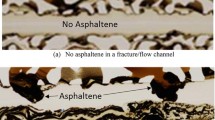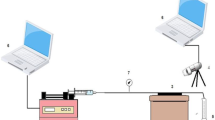Abstract
In this study, the main recovery mechanisms behind oil/water/gas interactions during the water-alternating-gas (WAG) injection process, in a network of matrix/fracture, were fundamentally investigated. A visual micromodel was utilized to provide insights into the potential applications of WAG process in fractured oil-wet media as well as the possibility of observing microscopic displacement behavior of fluids in the model. The model was made of an oil-wet facture/matrix network system, comprised of four matrix blocks surrounded with fractures. Different WAG injection scenarios, such as slug arrangements and the effects of fluid injection rates on oil recovery were studied. A new equation representing the capillary number, considering the fracture viscous force and matrix capillary force, was developed to make the experimental results more similar to a real field. In general, WAG tests performed in the fractured model showed a higher oil recovery factor compared with the results of gas and water injection tests at their optimum rates. The results showed that the presence of an oil film, in all cases, was the main reason for co-current drainage and double displacement of oil under applied driving forces. Furthermore, the formation of oil liquid bridges improved the recovery efficiency, which was greatly influenced by the size of fracture connecting the two matrix blocks; these connecting paths were more stable when there was initial water remaining in the media. Analyzing different recovery curves and microscopic view of the three phases in the transparent model showed that starting an injection mode with gas (followed by repeated small slugs of water and gas), could considerably improve oil recovery by pushing water into the matrix zone and increasing the total sweep efficiency.
Similar content being viewed by others
Abbreviations
- N c,mf :
-
Capillary number
- ΔP :
-
Pressure difference
- v x,f :
-
Velocity of phase x in the fracture
- μ x :
-
Viscosity of phase x
- L m :
-
Length of matrix
- k f :
-
Fracture permeability
- σ ox :
-
Interfacial tension of oil and phase x
- R m :
-
Hydraulic radius
- k m :
-
Matrix permeability
- K f :
-
Fracture permeability
- Q g,f :
-
Gas flow rate in fracture
- Q w,f :
-
Water flow rate in fracture
- w:
-
Water
- g:
-
Gas
- o:
-
Oil
- f:
-
Fracture
- m:
-
Matrix
- lab:
-
At laboratory condition
- res:
-
At reservoir condition
References
Campbell B.T., Orr F.M. Jr.: Flow visualization for CO2/crude-oil displacements, SPE 11958. SPE J. 25(5), 665–678 (1985)
Christensen, J.R., Stenby, E.H., Skauge, A.: Review of WAG field experience, SPE 39883. In: Proceedings of SPE International Petroleum Conference and Exhibition, Villahermosa. (1998). doi:10.2118/39883-MS
Christensen J.R., Stenby E.H., Skauge A.: Review of WAG field experience. SPE Res. Eval. Eng. 4(2), 97–106 (2001)
Danesh, A., Peden, J.M., Krinis, D., Henderson, G.D.: Pore level visual investigation of oil recovery by solution gas drive and gas injection. In: SPE 16956 presented at the 62nd Annual Technical Conference and Exhibition, Dallas. (1987). doi:10.2118/16956-MS
Dastyari, A., Bashukooh, B., Shariatpanahi, S.F., Sahimi, M.: Visualization of gravity drainage in a fractured sustem during gas injection using glass micromodel. In: SPE 93673 presented at 14th oil and gas show and conference, Bahrain. (2005). doi:10.2118/93673-MS
Dehghan A.A., Farzaneh S.A., Kharrat R., Ghazanfari M.H., Rashtchian D.: Pore-level investigation of heavy oil recovery during water alternating solvent injection process. Trans. Porous Media 83(3), 653–666 (2009). doi:10.1007/s11242-009-9463-5
Dehghan A.A., Kharrat R., Ghazanfari M.H., Vossoughi S.: Quantifying the role of pore geometry and medium heterogeneity on heavy oil recovery during solvent/co-solvent flooding in water-wet systems. J. Porous Media 14(4), 363–373 (2009). doi:10.1615/JPorMedia.v14.i4.80
Dong M., Foraie J., Huang S., Chatzis I: Analysis of immiscible water-alternating-gas (WAG) injection using micromodels. J. Can. Petrol. Tech. 44(2), 17–25 (2005)
Firoozabadi A., Markeset T., Dindoruk B.: Viscous displacement in fractured porous media. J. Can. Petrol. Tech. 36(9), 50–62 (1997). doi:10.2118/97-09-05
Geiger, S., Matthaei, S., Niessner, J., Helmig, R.: Black-oil simulations for three-component, three-phase flow in fractured porous media. SPE J. 14(2), 338–354. SPE- 107485-PA. (2009). doi:10.2118/107485-PA
Gorell, S.B.: Implications of water-alternate-gas injection, for profile control and injectivity. In: SPE 20210, Proceedings of SPE/DOE Enhanced Oil Recovery Symposium, Tulsa. (1990). doi:10.2118/20210-MS
Haghighi M., Xu B., Yortsos Y.C.: Visualization and simulation of immiscible displacement in fractured systems using micromodels: I. drainage. J. Colloid Interface Sci. 166, 168–179 (1994)
Heeremans, J.C., Esmaiel, T.E.H., van Kruijsdijk, C.P.J.W.: Feasibility Study of WAG Injection in Naturally Fractured Reservoirs, SPE 100033. In: Proceedings of SPE/DOE Symposium on Improved Oil Recovery, Tulsa. (2006). doi:10.2118/100034-MS
Lenormand R., Zarcone C., Sarr A.: Mechanisms of the displacement of one fluid by another in a network of capillary ducts. J. Fluid Mech. 135, 337–353 (1983)
Manrique E.J., Muci V.E., Gurfinkel M.E.: EOR field experiences in carbonate reservoirs in the United States. SPE Res. Eval. Eng. 10(6), 667–686 (2007)
Morrow N.R.: Wettability and its effect on oil recovery. SPE J. Petrol. Tech. 42(12), 1476–1484 (1990)
Novakowski K., Bickerton G., Lapcevic P., Voralek J., Ross N.: Measurements of groundwater velocity in discrete rock fractures. J. Contam. Hydrol. 82(1–2), 44–60 (2006)
Prieditis, J., Wolle, C.R., Notz, P.K.: A laboratory and field injectivity study: CO2 WAG in the San Andres formation of west Texas, SPE 22653. In: SPE Annual Technical Conference and Exhibition, Dallas. (1991). doi:10.2118/22653-MS
Rogers, J.D., Grigg, B.R.: A Literature analysis of the WAG injectivity abnormalities in the CO2 process, SPE 59329, Proceedings of SPE/DOE Improved Oil Recovery Symposium, Tulsa. (2000). doi:10.2118/59329-MS
Saidi, A.M.: Textbook of reservoir engineering of fractured reservoirs. TOTAL edition press, ISBN: 2-905 143-09-6 (1987)
Shedid A.S.: Influences of fracture orientation on oil recovery by water and polymer flooding processes: an experimental approach. J. Pet. Sci. Eng. 50(3-4), 285–292 (2006)
Sohrabi, M., Tehrani, D.H., Danesh, A., Henderson, G.D.: Visualization of oil recovery by water-alternating-gas injection using high-pressure micromodels. SPE J. 9(3), 290–301. SPE- 89000-PA. (2004). doi:10.2118/89000-PA
Sohrabi M., Danesh A., Jamiolahmady M.: Visualisation of residual oil recovery by near-miscible gas and SWAG injection using high-pressure micromodels. Trans. Porous Media 74(2), 239–257 (2008)
Thomas, L.K., Dixon, T.N., Pierson, R.G.: Fractured reservoir simulation. SPE J. 23(1), 42–54. SPE-9305-PA. (1983). doi:10.2118/9305-PA
van Dijke, M.I.J, Sorbie, K.S., Sohrabi, M., Danesh, A.: Three-phase flow WAG processes in mixed-wet porous media: pore-scale network simulations and comparison with water-wet micromodel experiment. SPE J. 9(1), 57–66. SPE- 87822-PA. (2004). doi:10.2118/87822-PA
van Dijke M.I.J., Sorbie K.S., Sohrabi M., Danesh A.: Pore-scale modeling of three-phase flow in mixed-wet porous media: multiple displacement chains. J. Pet. Sci. Eng. 52, 71–86 (2006)
van Dijke, M.I.J., Lorentzen, M., Sohrabi, M., Sorbie, K.S.: Pore-scale simulation of wag floods in mixed-wet micromodels. SPE J. 15(1), 238–247. SPE-113684-PA. (2010). doi:10.2118/113684-PA
Van Golt-Racht T.D.: Textbook of Fundamentals of fractured reservoir engineering. Elsevier Scientific publication, New York (1982) ISBN: 0-444-42046-0
Warren J.E., Root P.J.: The behavior of naturally fractured reservoirs. SPE J. 3(3), 245–255 (1963). doi:10.2118/426-PA
Author information
Authors and Affiliations
Corresponding author
Rights and permissions
About this article
Cite this article
Dehghan, A.A., Ghorbanizadeh, S. & Ayatollahi, S. Investigating the Fracture Network Effects on Sweep Efficiency during WAG Injection Process. Transp Porous Med 93, 577–595 (2012). https://doi.org/10.1007/s11242-012-9970-7
Received:
Accepted:
Published:
Issue Date:
DOI: https://doi.org/10.1007/s11242-012-9970-7




